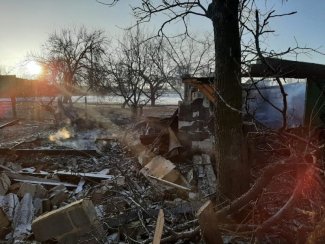Russians capture part of Soledar town. Day 321 of the war

Russian forces have taken a large part of the town of Soledar, but do not fully control it, and clashes are still expected to take place there. According to some sources, the Ukrainian troops remaining in the area (most of whom were expected to withdraw) are surrounding the town. Fighting is continuing for the towns and villages along the railroad and the Bakhmut-Siversk road (from Krasna Hora, through the western outskirts of Soledar, to Rozdolivka). The attackers are pushing into the eastern part of Bakhmut, and are aiming to outflank Klishchiivka, the last remaining village under enemy control south of it.
Hostilities are also taking place south and east of Siversk, northwest of Horlivka, and in a wide arc west of Donetsk, where Marinka remains the site of the heaviest clashes. The Russians have attempted assaults west of Vuhledar, west and north of Kreminna, and north of Kupiansk (in the area of Dvorichna). Ukrainian sabotage and reconnaissance groups were also said to be operating in the western part of the Donetsk oblast, and on the border of the Kharkiv and Luhansk oblasts. According to local reports, the invaders are to expand three lines of fortifications around Melitopol: in the directions of Kherson, Vasylivka (Zaporizhzhia) and Berdyansk. Defensive positions should also be built in the centre of the city, and on the road between it and occupied Crimea.
Russian artillery and aviation continue to shell and bombard the positions and facilities of Ukrainian forces along the line of contact and in border areas. On 9 January, the area around Huliaipole in the Zaporizhzhia oblast was shelled a record 360 times. Kherson, Nikopol and Ochakiv, along with the surrounding areas, are still the main targets outside the battle areas. More rockets fell on Kramatorsk, Kostiantynivka, Kharkiv and Lyman.
The Czech Republic is preparing to supply Ukraine with another batch of T-72 tanks, while the Swedish government has confirmed its intention to hand over 155-mm cannon howitzers mounted on Archer vehicle platforms (they are the equivalent of the French CAESAR howitzers). The delivery of a small batch of Challenger-2 tanks (10 units, which would equip one company) is being considered by the British government, but no final decision has yet been taken. According to Politico, Washington is considering the possibility of including Stryker wheeled armoured personnel carriers in one of its next military support packages. In January, Pakistan will deliver (via Gdansk) 159 containers with 155mm ammunition and components (among other cargoes) for multi-barrelled missile launchers, in exchange for the Motor Sich company handling Pakistani helicopters. The periodical Foreign Policy reports that Turkey has been transferring Cold War-era cluster munitions to Ukraine since November 2022.
Canada’s defence ministry has announced its intention to purchase the US NASAMS air defence system for the Ukrainian army. In turn, the Pentagon has entered into a US$40 million contract to deliver 14 Vampire counter-drone systems (the first four will be delivered in the summer at the earliest). Ammunition for the Gepard self-propelled anti-aircraft guns remains a problem: Spain’s defence minister has announced that Switzerland has not agreed to re-export the armaments licensed to it.
On 11 January, thanks to the mediation of Turkish authorities, talks between the ombudsmen of Ukraine and Russia were held in Ankara. A perfunctory communiqué stated that Dmytro Lyubinets and Tatyana Moskalkova had discussed numerous humanitarian issues and matters related to the provision of human rights assistance to citizens of both countries. The sides also exchanged specific proposals on working out a formula for releasing prisoners, including civilians.
Georgia has rejected Kyiv’s request for the Buk missile systems which Ukraine gave it during the 2008 war, on the grounds that the systems were not donated but purchased. Kyiv’s request also included a suggestion that Georgia delivery the Javelin anti-tank systems supplied them by the United States at the time.
The head of the Kyiv oblast’s military administration, Oleksiy Kuleba, inspected defensive positions around the capital, including shooting positions and equipment housing field infrastructure. Kuleba stressed that the positions were being reinforced in response to reports of increased activity by enemy forces in Belarus. In turn, Kyiv’s defence commander Oleksandr Pavlyuk said that some of the armaments and military equipment arriving in Belarus from Russia had come from long-term storage warehouses. The task of bringing them to a condition that would allow them to operate on the battlefield has been entrusted to Belarusian repair facilities. Meanwhile, the Border Service of Ukraine maintains that there is still no increase in tension on the border with Belarus.
On 11 January, the National Police of Ukraine reported that 2300 criminal cases of collaboration have been opened since the beginning of the war. The charges range from supporting the aggressor on social networks, to justifying the invasion, to holding positions in the occupation authorities.
Commentary
- The capture of Soledar by Russian forces (here, soldiers of the Airborne Forces and mercenaries from the so-called Wagner group) and their advance north of Bakhmut, cutting its communications with Siversk and threatening to cut off the main line of communication (the M03 highway) with Sloviansk, will put the defenders in a difficult situation. Although fighting in Soledar and for control of the Bakhmut-Siversk road and railroad is still ongoing, it is unlikely that the Ukrainians will be able to regain their lost positions anytime soon or continue holding out east of the river Bakhmutka. This would require a significant reinforcement of the grouping in this direction at the expense of other areas of operations.
- If the area in question falls under Russian control, and the Russians are reinforced in the Klishchiivka area and west of Kreminna, this will outflank both Bakhmut and the Ukrainian grouping in the Siversk area. However, outflanking Bakhmut does not automatically mean the town will fall, as it still has Ukrainian-controlled connections in the westward direction with Kramatorsk (the main one via Kostiantynivka and a local road via Chasiv Yar). The invaders’ actions will also be hampered by a belt of hills on the western bank of the Bakhmutka, which offer convenient positions for defence.
- It cannot be ruled out that if making further progress becomes impossible, in the near future the Russians will shift the main burden of fighting to the south and north of the Bakhmut area, striking at Kostiantynivka and Lyman respectively. On the other hand, it is unlikely that the aggressors will expand upon their success and attack in the direction of Sloviansk along the M03 highway, as there is currently no large strike grouping in the Bakhmut area. It should be assumed that the Russian forces will continue operations on a business-as-usual basis, trying to gradually push the enemy out of the positions they have occupied in those places where they have been able to break their defences.




